 tallgrass: an osage reverie series
tallgrass: an osage reverie series
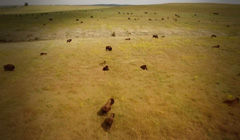
tallgrass

prarie reverie

american bison
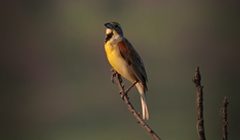
dickcissel
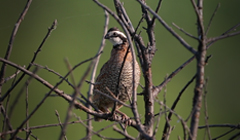
northern bobwhite (1)
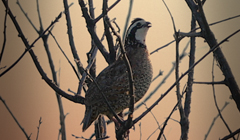
northern bobwhite (2)

hummingbirds on bull thistle
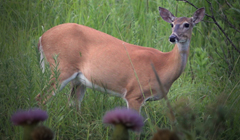
white-tailed deer

moonrise with scissor-tailed flycatchers

cliff swallows at sunset
“As to scenery, while I know the standard claim is that Yosemite, Niagara Falls, the Upper Yellowstone and the like afford the greatest natural shows, I am not so sure but the prairies and plains, while less stunning at first sight, last longer, fill the esthetic sense fuller, precede all the rest, and make North America’s characteristic landscape.” –Walt Whitman
This body of work is composited together from photos and video taken in the Tallgrass Prairie Preserve of the Osage, in Oklahoma. The region is called “The Osage” by Oklahomans, referring to the name of the county and the Native American tribe to which the land belonged. The Tallgrass Prairie was an important hunting ground for Native American tribes such as the Wichita, Osage, and Kaw. Originally spanning portions of fourteen states from Texas to Minnesota, urban sprawl and the conversion of the prairie to crops and grazing land for cattle have left less than 10% of this magnificent American landscape intact.
The Tallgrass Prairie Preserve is the largest remaining protected expanse of tallgrass prairie left on earth. The Preserve is owned and managed by The Nature Conservancy, a leading conservation organization working around the world to protect ecologically important lands and waters for posterity. Since 1989, the organization has proven successful in restoring this fully functioning portion of the tallgrass prairie ecosystem with the use of nearly 2500 free roaming bison and a “patch-burn” model approach to prescribed burning. I find it interesting that conservation efforts (led by The Nature Conservancy), in effect, are recreating the American landscape of the tallgrass prairies on the preserve by reintroducing bison, eliminating invasive plant species, prescribed burns, etc. A landscape, curated and preserved, shaped by man’s intervention dating back to pre-history. I imagine the prairie in a reverie of sorts, these videos at first appear natural, but are a façade.
The work expands a moment with moving image and sound, and includes icons of the region such as scissor-tailed flycatchers, Oklahoma’s state bird, and American Bison which once roamed the vast prairie in massive herds. Imagery is highly composed, I view this as “recreating” the landscape, or recreating an idealized version of the landscape. However, there seems to be something uncanny and subtly confrontational about the work. Immersed in dream-like composites of the tallgrass landscape, augmented with ethereal soundscapes by Norbert Herber, viewers move through the space and nature seems to be interrupted by their presence (accompanied by generative soundscapes created by Norbert Herber).
 mnemonic passages series
mnemonic passages series
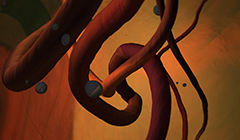
memory form (1)

memory form (2)
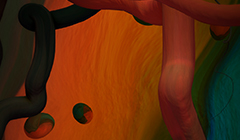
memoria
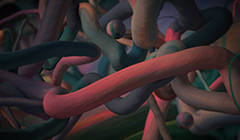
mnemonic passage

astrocyte
A Memory Palace is an imaginary location in your mind where mnemonic images are stored for recall. The most common type of memory palace involves making a journey through a place that is known well, like a home, building, or town. I am interested in the composition of memory and its abstract architecture. I imagine a kind of cosmological and neural space, a cerebral landscape or mindscape where memories take form.
This work is inspired by saturated electron microscopic images of the human brain, and various images of our universe taken by the Hubble Space Telescope, among others. It is amazing how similar these images can sometimes appear, and their magnificence and beauty is striking. Not wanting to simply recreate these images in moving form, but rather use them as a starting point, these works have an ambiguous sense of scale and space, reminiscent of the brilliantly colored images of our physical and cerebral universe.
The vein that runs through my work is an application of ideas related mostly to abstract expressionism in my experimentation with the moving image and the exploration of the creative process as a means of self-expression. Carrying over ideas and processes from my Painting background and transferring knowledge to my Digital Media studio art practice, I work with non-linear video editing software, using clips and source files much like colors on a painter’s palette or pieces in assembling collage. I enjoy mixing and layering clips, blending together image and time, creating meditative experiences through my work.
 glitch: karmic_lapse series
glitch: karmic_lapse series

kind of portrait

ode (to a memory)

popUp

karmic_lapse
Throughout the creative process, collaboration ensues between the medium and myself. Decisions bring about an exchange of cause and effect relationships as elements begin to emerge in the work. At the end of the creative process, further collaboration takes place as viewers assume a certain amount of control by contributing their reflections, experiences, and interpretations.
Art is a psychological phenomenon that can be empirically reduced to a subject’s perception of a constructed sensory stimulus. As such, a work of art exists only in the minds of those that perceive it. This relationship between viewer and art fascinates me and has led me to investigate ways of incorporating the viewer into my work.
Karma is the sum of one’s actions in this and previous states of existence and is viewed as deciding one’s fate in future existences. The interactive works use a camera feed that is processed live and abstracted into the imagery. The camera as both source and sensor allow an element of randomness and serendipity to exist as the viewer becomes part of the work. Viewers stand and move in front of the work causing small libraries of videos to shuffle and be re-edited, in some cases a series of stills or delayed video is captured and incorporated into the composition. The effect is one where imagery is altered and recomposed by virtue of one’s presence and the act of viewing.
This work collages live captured images in combination with pre-recorded video clips and images enabling a more free association of ideas. Engaging in dialog relative to the work of artists such as Rob Rauschenberg, and Andy Warhol, these works allow chance to play a role in the placement and/or combination of formal elements within the composition. Personal and found images are randomly placed and collaged so that there is no strict predetermined arrangement or meaning embedded within the work.
 splitting time series
splitting time series

bits

tmfrm
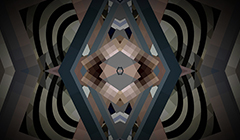
tmsplttr
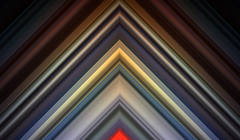
prsm

oculus
A work of art has an ability to make a connection and take on a life of its own. It’s fascinating how we can connect with an image, poem, or a song. It’s as if we recognize something of ourselves in the things we connect to, something shared that we have in common. Sometimes, the meaning we attach morphs over time and the relevance shifts, but the basic truth, the connection remains.
In working with time-based media, I have become more aware of how I perceive and process time. I perceive time as a measurement of change, a collection of tiny moments in sequence. Time can be represented as an object moving through space, or a shifting color of a pixel in a video screen. We tend to record time according to the repetition and flow of events, dividing it up into small manageable blocks. But life is more than just the sum of its parts, it’s how the moments connect and those we connect with draw the narrative throughout the chapters of our journey.
I wanted to develop the relationship between the work and the viewer further and looked to the unblinking eye of a camera, specifically a webcam, to begin capturing and incorporating the viewer into the composition. The first of these works was Oculus. Within the work, overlapping shapes slowly rotate and blend to create various colors based on the RGB color wheel and the additive properties of light. The animated shapes come together creating an abstraction of a lidless eye, the viewer is captured in the center of its gaze and the composition becomes more dynamic in response to their presence.
In the splitting time series of interactive installations, camera feeds are processed live and then abstracted into colorful mosaics of time. The imagery is abstracted into simple geometric forms of pure abstraction. Repetitive systems are affected and animated by the viewers’ presence and the act of viewing. Movement in front of the work causes color interactions to occur within the compositions. I see this work within the context of abstract expressionism and the tradition of Color Field artists such as Mark Rothko and Barnett Newman. Within these works, color is sourced from the viewer in their surroundings and divorced from objective context to become the subject itself.
 nāga series
nāga series

F5
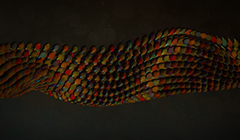
nāga (red)
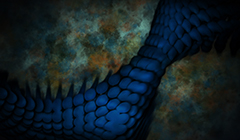
nāga
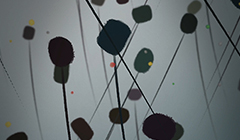
spring breeze
Traditions about nāgas are very common in all the Buddhist countries of Asia. Nāga, is the Sanskrit word for a spirit being that takes the form of a very great snake. In Tibet, the nāga can take the form of a dragon serpent living in lakes or underground streams as a sort of deity that can affect weather patterns and conjure thunderstorms.
In 2010, I traveled to China and Tibet and brought along a book of Buddhist philosophies and teachings that used the nāga, or dragon, as a metaphor for fear. It went on to suggest that we as individuals must meet our fear, we must meet our dragon and find the edges of our self and grow as conscious beings. This was an attractive analogy to me, I saw a truth or value in it that was familiar.
It's easy correlating this concept to how I experience the creative process. I am aware of the fear that lurks on a blank sheet of paper, a blank canvas, digital or otherwise. The creative process can cause anxiety at times, as do change and life experiences. It takes nerve to leap into what is unknown or unfamiliar, to make that first mark and meet your dragon.
When starting to work with video and moving images, I first was interested in recording somewhat random physical phenomena such as smoke, the surface of water, and dripping paint. In this series, I began experimenting with code and mathematical expressions to introduce additional elements of randomness and unpredictability to the work. I recognize this as a kind of collaboration with the software and view this process along the lines of abstract expressionism and action painting or notions of automatism in terms of automating the "machine" through code.
 matter of process series
matter of process series

cluster

io

comp 3 (terra)
This small series combines the sensibilities of painting with those of video by exploring ideas of abstract expressionism using high definition footage of materials such as paint manipulated across surfaces or poured through the air. Various post-production techniques inside of non-linear editing software further manipulate the footage to resemble an altogether different space and illusion than that of the original. Thinking purely of space, color, and movement of form, the videos are composed as if they were, in a sense, moving, time-based paintings.
My aim was to find a way to create such a “time-based painting” which does not need to rely on the cinematic structure of plot, character arc, beginning, middle, or end. I wanted to create a sense of the “mark” in drawing, or the “stroke” in painting with this work, as well as the feeling of glazed color possible with oil paint and a sense of the painter’s light.
 tallgrass: an osage reverie series
tallgrass: an osage reverie series  mnemonic passages series
mnemonic passages series
 glitch: karmic_lapse series
glitch: karmic_lapse series
 splitting time series
splitting time series
 nāga series
nāga series
 matter of process series
matter of process series






























